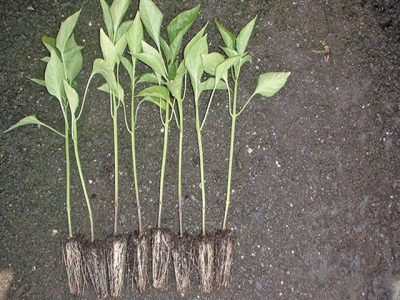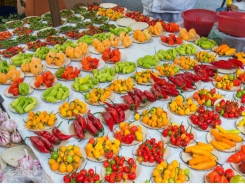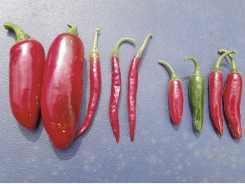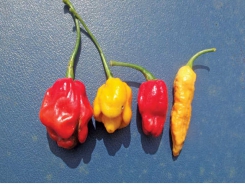Producing capsicum seedlings in soil beds

The usual way to grow chillies and peppers is to plant the seed in cavity seed trays with a good growing medium.
If you have seedlings this size, they should be hardened and planted deep, so that the lowest leaves are just above the surface of the soil.
This ensures uniformity and gives the seedlings the best chance of survival. Certainly, when hybrids are used, the seed price makes it essential to use cavity seedlings.
But even with open-pollinated varieties, cavity seedlings are so much safer and easier, that most growers opt for this method anyway.
If, however, you want to grow your plants in soil seedbeds (which may be the case if using open pollinated varieties in remote areas), ensure that the soil is free of eelworm and disease pathogens.
If these are picked up by the newly emerged seedling, the plant will be disadvantaged from an early stage.
The plants will be ready for transplant only after about two months, so these organisms have plenty of time to launch an attack.
It is therefore advisable to use raised, fumigated seedbeds, in order to clear the soil of all potentially harmful organisms and control weeds. Many weeds are fast off the mark and capsicums are slow to germinate and develop.
Cover the beds with shade-netting supported by hoops, and use micro- or mini-sprinklers. Sow the seedlings at a density that allows all the plants to be ready for lifting at the same time.
With the soil-grown method, the plants must be hardened before transplanting, preferably by reducing water to place the plants under stress. The leaves will develop a duller appearance.
To harden plants in areas where rain is likely, reduce the nitrogen level until the plants develop a lighter colour and growth slows down.
Add nitrogen again a few days before lifting. Irrigate the plants, and remove them the following day with a garden fork. This will keep most of the plant’s root system intact and retain soil around the roots.
Treating the seeds
The seeds must be free of bacterial spot. If you suspect that it’s present, treat the seeds with hot water to kill the pathogen.
Using a good dairy thermometer, heat a pot of water to 51°C, keeping a kettle of hot water and a jug of cold water handy.
Place the seed into the pot and add a little water from the kettle to bring the temperature back up to 51°C. Keep stirring while maintaining the temperature at this level by adding hot or cold water as required.
After 30 minutes, pour the contents out through a sieve and dry the seed in the shade. If you want to use the treated seed immediately, dry it just enough to be able to plant. In this way, germination will be quicker than with dry seed.
Pepper mild mottle virus (PMMoV) can also be transmitted by seed.
It’s highly unlikely that seed from a seed company will be infected, but if you are using your own seed – in the case of paprika production, for example – and suspect PMMoV, you can also treat the seed.
The method used is different to the one described. If you have this problem, get in touch with me and I will explain the procedure. It works very effectively.
Temperature
Capsicum seed is slow to germinate and requires a temperature of between 25°C and 30°C to germinate in eight days.
At a lower temperature, the seed will take much longer to germinate. Be aware of this if starting off in spring and make a plan to keep the seed at a temperature of at least 25°C.
The longer a seed takes to germinate, the poorer the germination and uniformity of germination. This is especially so with older seeds. Fresh seed always germinates faster.
Related news
Tools

Phối trộn thức ăn chăn nuôi

Pha dung dịch thủy canh

Định mức cho tôm ăn

Phối trộn phân bón NPK

Xác định tỷ lệ tôm sống

Chuyển đổi đơn vị phân bón

Xác định công suất sục khí

Chuyển đổi đơn vị tôm

Tính diện tích nhà kính

Tính thể tích ao




 Raising capsicum seedlings
Raising capsicum seedlings  Understanding chilli pungency
Understanding chilli pungency